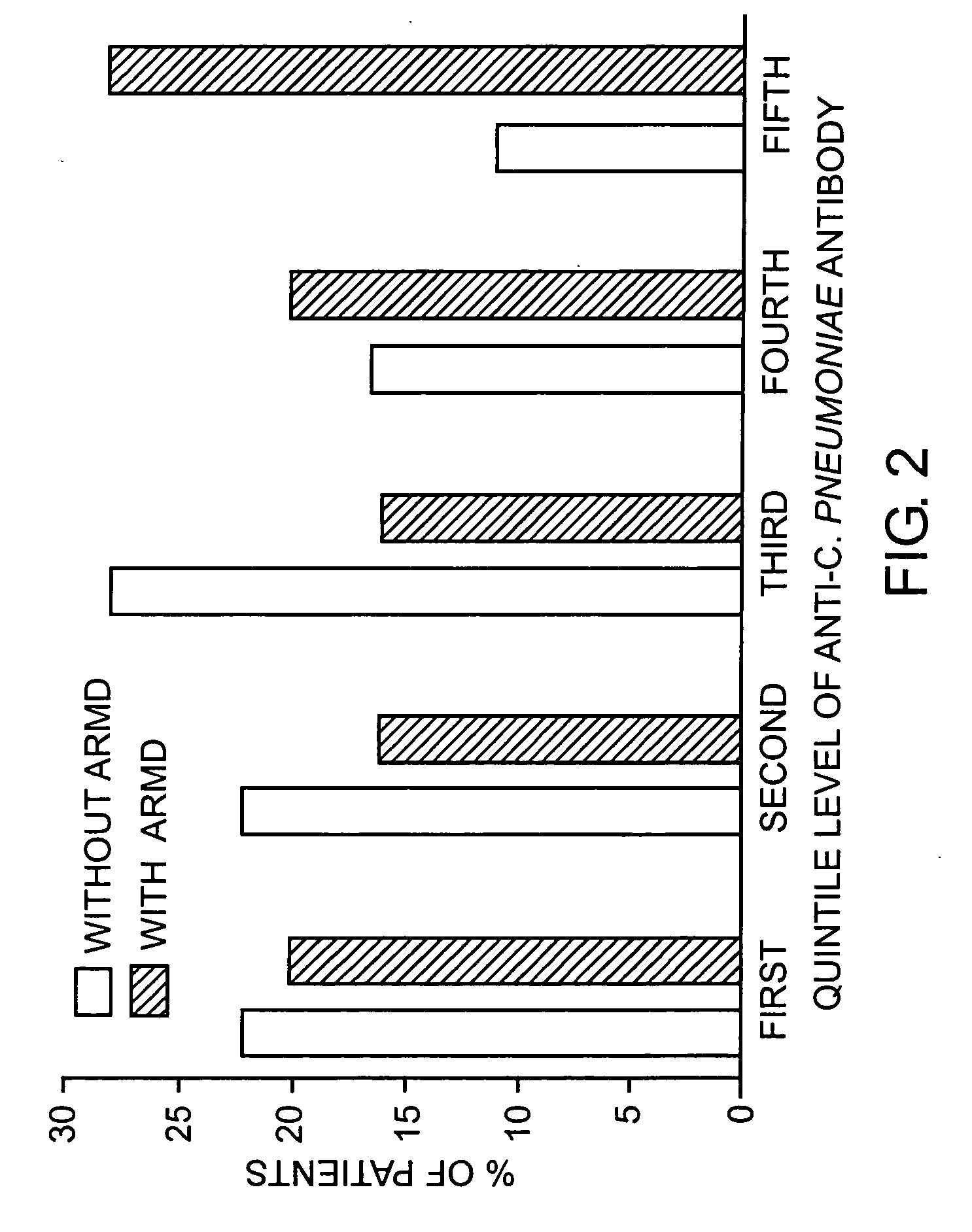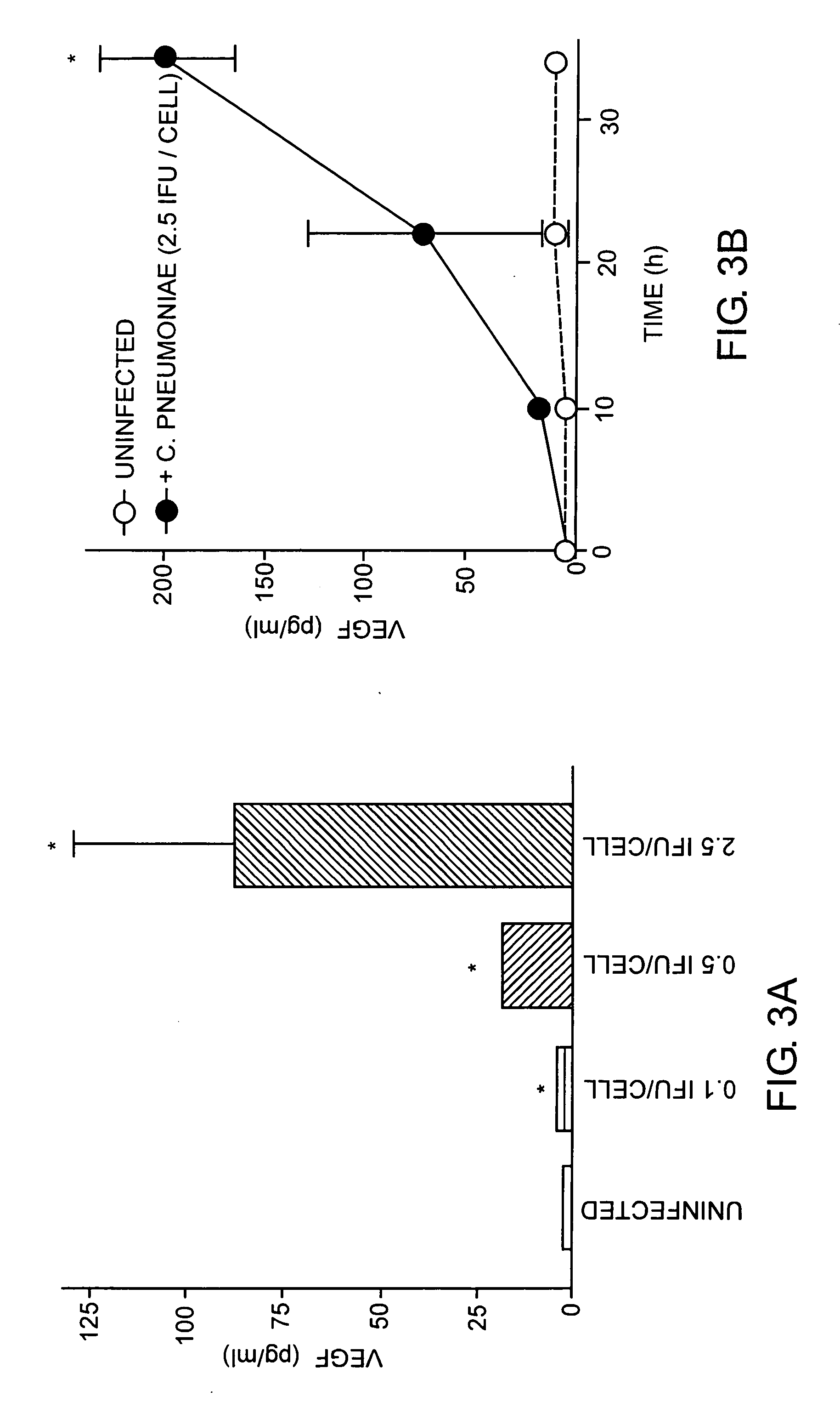Chlamydia pneumoniae associated chronic intraocular disorders and treatment thereof
a technology of chronic intraocular disorders and chlamydia pneumoniae, which is applied in the field ofchronic intraocular disorders, can solve the problems of destroying the photoreceptor cells of the retina, and affecting the onset and/or development of the disease.
- Summary
- Abstract
- Description
- Claims
- Application Information
AI Technical Summary
Benefits of technology
Problems solved by technology
Method used
Image
Examples
example 1
Serological Studies Showing a Correlation Between Chlamydia Pneumoniae Infection and the Onset of Age-related Macular Degeneration
[0078] Patients, all of whom were older than 55 years, were enrolled consecutively to either a case group of patients having age-related macular degeneration (ARMD patients) or a control group of patients without age-related macular degeneration (non-ARMD patients). The case group consisted of 25 patients with clinical evidence of age-related macular degeneration as determined by funduscopy. The control group consisted of 18 patients without clinical evidence of age-related macular degeneration by funduscopy.
[0079] Interview and chart-review data were gathered on several risk factors for age-related macular degeneration and cardiovascular disorders in order to assess potential confounding influences. Assessed factors included age, sex, as well as a history of smoking, diabetes, hypertension, hyperlipidemia, and coronary artery disease. Tobacco use was d...
example 2
Tissue Studies Showing a Correlation Between Chlamydia Pneumoniae Infection and the Onset of Age-Related Macular Degeneration
[0090] To further substantiate the presence of Chlamydia pneumoniae in the CNVM of patients diagnosed with age-related macular degeneration, serial sections of CNVM specimens were isolated from nine patients and analyzed either by PCR to detect the presence of Chlamydia pneumonia specific nucleic acids in the samples or by immunohistochemistry using an anti-Chlamydia pneumoniae monoclonal antibody to detect the presence of a Chlamydia pneumonia specific antigen in the samples.
[0091] Materials and Methods
[0092] Materials. Unless otherwise noted, all reagents were purchased from Sigma (St. Louis, Mo.).
[0093] Tissue Preparation. Human studies committee approval was obtained at the Massachusetts Eye & Ear Infirmary and Massachusetts General Hospital (Boston, Mass.). Sterile technique was used to handle all specimens. Surgical excision of submacular CNVM was pe...
example 3
Chlamydia pneumoniae Infects Certain Cells, and Induces Production of Angiogenic Immunomodulators
[0106] This experiment was performed to determine if Chlamydia pneumoniae can alter cell function in ways that cause age-related macular degeneration. To perform this experiment, human monocyte-derived macrophages and RPE cells were infected with varying doses of Chlamydia pneumoniae and assayed for the production of pro-angiogenic and inflammatory immunomodulators.
[0107] Human peripheral blood mononuclear cells were isolated by Ficoll-Hypaque centrifugation from healthy donor blood. Monocytes were separated from lymphocytes by incubating cells at 37° C. for 1 hour in RPMI-1640 medium (Sigma) followed by washing 5× with HBSS (Sigma). In separate experiments, isolated cells were >90% monocytes by anti-CD14 staining (Kalayoglu et al. (1998) J. INFECT. DIS. 177:725-729) and viability was >95% as assessed by trypan-blue dye exclusion. Monocytes were cultured at 37° C. for 5-7 days in RPMI-...
PUM
| Property | Measurement | Unit |
|---|---|---|
| Antimicrobial properties | aaaaa | aaaaa |
Abstract
Description
Claims
Application Information
 Login to View More
Login to View More - R&D
- Intellectual Property
- Life Sciences
- Materials
- Tech Scout
- Unparalleled Data Quality
- Higher Quality Content
- 60% Fewer Hallucinations
Browse by: Latest US Patents, China's latest patents, Technical Efficacy Thesaurus, Application Domain, Technology Topic, Popular Technical Reports.
© 2025 PatSnap. All rights reserved.Legal|Privacy policy|Modern Slavery Act Transparency Statement|Sitemap|About US| Contact US: help@patsnap.com



